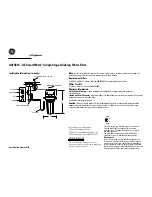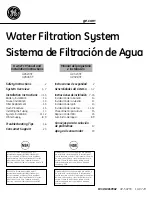
• Remove the Activated Carbon Filter Housing
and empty. Remove the wrapping and install
the Activated Carbon Post Filter. Firmly tight-
en the Housing hand tight only.
• Disconnect the yellow product water tubing
that runs from the Holding Tank to the
Manifold (see Fig. 1, page 1). Put 50 drops of
bleach (this is tsp. or 3 ml) into the tubing
and reconnect it.
• Slowly open the Feed Water Saddle Valve.
When water begins dripping out of the
Dispensing Faucet, in the following order,
close the Faucet and then open the Holding
Tank Valve.
• Do not open the Faucet for at least 6 hours.
• Discard the first three full tanks of water pro-
duced; they will contain chlorine.
• When the Faucet if first opened, expect air
and carbon fines (very fine black powder),
from the new Activated Carbon Post Filter to
be rinsed out. This is normal for the first tank
of water.
SECTION VI. TECHNICAL DATA
A. Water Quality
Water quality is normally measured with a special
meter that measures the water’s ability to conduct
electricity. The more dissolved solids in the water,
the higher the conductivity. The results are usually
reported in
Parts per Million
(ppm) or
Milligrams
per Liter
(mg/l) of
Total Dissolved Solids
(TDS).
(Although technically they are not exactly equal, in
most discussions ppm = mg/l.)
R.O. Membranes are rated by the amount of dis-
solved solids that are rejected. This rating is a
ratio of the TDS in the feed water to the TDS in
the product water and is reported as
Percent
Rejection
. If the feed water contained 100 ppm of
TDS and the product water contained 10 ppm of
TDS, 90 ppm have been rejected and the reject
ratio is 90%.
Percent Rejection =
Feed TDS–Product TDS x 100%
Feed TDS
EXAMPLE: Feed water is 500 ppm TDS and the
product water is 75 ppm TDS.
Percent Rejection = 500 – 75 x 100%
500
Percent Rejection = 0.85 x 100% or 85%
B. Water Quantity
Water quantity is termed
Flux
or
Product Water
Rate
and is measured as the amount of water pro-
duced in one day. It is reported as
Gallons per
Day (gpd) or
Liters per Day
(lpd).
The flow of water to drain is the
Reject Water
Rate
and is measured as Gallons per Day (gpd) or
as
Milliliters per Minute
(ml/min).
Milliliters per minute x 0.38 = gallons per day
EXAMPLE: The drain flow will fill a graduated
cylinder to the 150 ml mark in one minute.
150 ml/min. x 0.38 = 57 gpd
If the container available measures ounces, use
the following conversion:
Ounces per minute x 11.2 = gallons per day
EXAMPLE: The product flow will fill 2 ounces
n two minutes.
2.5 oz. ÷ 2 min. = 1.25 oz./min.
1.25 oz./min. x 11.2 = 14 gpd
The
Reject Ratio
is the amount of water produced
compared to the amount of water flowing to drain.
Reject Ratio = Reject Rate_
Product Rate
EXAMPLE: The product rate is 14 gpd and the
eject rate is 56 gpd.
Reject Ratio = 56 ÷ 14
Reject Ratio = 4 or 4–to–1
The
Percent Recovery
is another way to measure
the amount of water produced as compared to the
amount actually used.
% Recovery = Product Rate x 100%
Feed Rate
NOTE: The total flow or feed water rate into the sys-
tem is the sum of the product flow and the drain
flow.






































